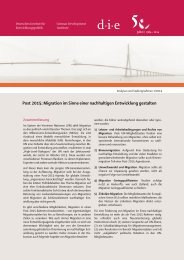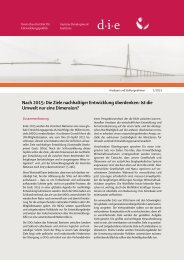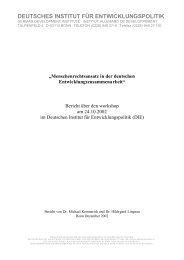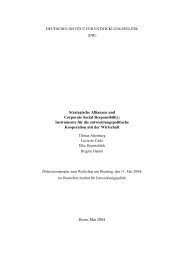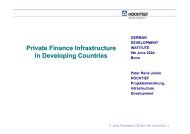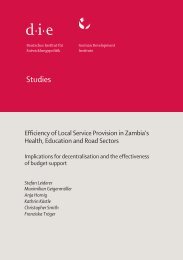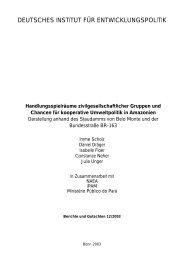Middle East / North Africa and the Millennium Development Goals ...
Middle East / North Africa and the Millennium Development Goals ...
Middle East / North Africa and the Millennium Development Goals ...
Create successful ePaper yourself
Turn your PDF publications into a flip-book with our unique Google optimized e-Paper software.
Markus Loewe<br />
2 <strong>Millennium</strong> Declaration <strong>and</strong> <strong>Millennium</strong> <strong>Development</strong><br />
<strong>Goals</strong><br />
2.1 Historical background <strong>and</strong> genesis of <strong>the</strong> <strong>Millennium</strong><br />
Declaration<br />
The <strong>Millennium</strong> Summit is <strong>the</strong> outcome of a development that entailed an<br />
at least partial departure from <strong>the</strong> so-called Washington Consensus, which<br />
dominated <strong>the</strong> international debate during <strong>the</strong> 1980s <strong>and</strong> rested squarely on<br />
neoliberal economic <strong>the</strong>ory (Gsänger 1996a; Eberlei 2000). It found expression<br />
above all in <strong>the</strong> stabilization <strong>and</strong> structural adjustment programs<br />
(SAPs) of <strong>the</strong> International Monetary Fund (IMF) <strong>and</strong> <strong>the</strong> World Bank that<br />
provided for consolidation of <strong>the</strong> current accounts <strong>and</strong> budgets of indebted<br />
developing countries, continuous <strong>and</strong> noninterventionist monetary <strong>and</strong> fiscal<br />
policies, <strong>and</strong> structural market reforms (market opening, deregulation,<br />
<strong>and</strong> privatization). Poverty reduction was largely equated with higher economic<br />
growth, <strong>the</strong> assumption being that such growth would, sooner or<br />
later, benefit <strong>the</strong> poor through trickle-down effects (Decker 2003, 488).<br />
In <strong>the</strong> early 1990s, however, it gradually become apparent that this assumption<br />
was, at least in its <strong>the</strong>n current form, not tenable. Indeed, in<br />
many developing countries – above all in <strong>Africa</strong>, but also in Latin America –<br />
poverty had even worsened under <strong>the</strong> SAPs (Decker 2003, 488; Betz 2003,<br />
456). As early as <strong>the</strong> mid-1980s UNICEF, <strong>the</strong> UN Children’s Fund, voiced<br />
criticism of <strong>the</strong> high costs exacted by <strong>the</strong> SAPs <strong>and</strong> called for “adjustment<br />
programs with a human countenance.” This dem<strong>and</strong> was underpinned programmatically<br />
by <strong>the</strong> United Nations <strong>Development</strong> Programme (UNDP),<br />
which, in 1990, released its first Human <strong>Development</strong> Report (HDR), a<br />
counter piece to <strong>the</strong> World Bank’s World <strong>Development</strong> Report. The HDR<br />
argued that economic growth did by no means automatically come along<br />
with social development (e.g. on education <strong>and</strong> health indicators) (UNDP<br />
2000). The report fur<strong>the</strong>r noted critically that <strong>the</strong> development debate was<br />
largely dominated by a one-dimensional, purely economic underst<strong>and</strong>ing<br />
of poverty. Based on <strong>the</strong> capabilities approach pioneered mainly by Amartya<br />
Sen (Sen 1981; Sen 1999), poverty was now defined as multiple deprivation<br />
of capabilities, i.e. as a lack of means that are needed to carry out<br />
<strong>the</strong> activities one cherishes <strong>and</strong> to live a life of self-determination (Lipton /<br />
Ravallion 1995).<br />
26 German <strong>Development</strong> Institute



